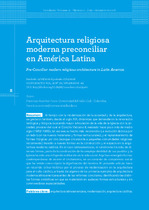Mostrar el registro sencillo del ítem
Arquitectura religiosa moderna reconciliar en América Latina
| dc.contributor.author | Ramírez Potes, Francisco | |
| dc.coverage.spatial | Seccional Medellín | spa |
| dc.date.accessioned | 2021-01-22T13:38:26Z | |
| dc.date.available | 2021-01-22T13:38:26Z | |
| dc.date.issued | 2016 | |
| dc.identifier.uri | http://hdl.handle.net/20.500.11912/7533 | |
| dc.description | p. 8 - 42 | spa |
| dc.description.abstract | Al tiempo con la modernización de la sociedad y de la arquitectura, se gestaron también, desde el siglo XIX, dinámicas que demandaron la renovación teológica y litúrgica, buscando mayor articulación de la vida de la Iglesia con la sociedad, proceso del cual el Concilio Vaticano II, realizado hace poco más de medio siglo (1962-1965), tal vez sea su hecho más reconocido. La evolución técnica por un lado (con los nuevos materiales y formas estructurales), y el replanteamiento de formas litúrgicas por otro (aunque circunscrita a pequeñas comunidades religiosas inicialmente) llevarán a nuevas formas en la construcción y el espacio en la arquitectura moderna católica. En el caso latinoamericano, el catolicismo ha sido, de diversas formas, parte de la construcción de la compleja identidad de sus pueblos y la Iglesia ha sido una influyente institución en la vida social. Aquí han emergido formas contemporáneas de asumir el cristianismo, en un contexto de compromiso social que ha tenido como objeto la dignificación del hombre. El presente artículo hace un recorrido crítico-histórico por el proceso de modernización en la arquitectura para el culto católico, a través de algunos de los primeros ejemplos de arquitectura moderna latinoamericana antes de las reformas conciliares, identificando las distintas formas simbólicas en que se materializó en audaces formas estructurales y en conmovedoras espacialidades. | spa |
| dc.description.abstract | Along with the modernization of society and architecture, some dynamics took place since the 19th century, which demanded for theological and liturgical renewal, looking for a greater articulation between the life of the Church and society. In this process, the II Vatican Council, which was launched little more than half a century ago (1962-1965), perhaps plays the most recognized role in such articulation. The technical evolution, on the one hand (with new materials and structural forms), and the rethinking of liturgical forms, on the other (although circumscribed to small religious communities initially), will lead to new forms in the construction and the space in Catholic modern architecture. In the Latin American case, Catholicism has been, in different ways, part of the construction of the complex identity of their peoples and the Church has been an influential institution in social life. Contemporary forms of assuming Christianity have emerged here, in a context of social commitment whose object has been the dignity of man. This article makes a critical-historical tour around the process of modernization in architecture for the Catholic worship, through some of the earliest examples of pre-conciliar modern Latin American architecture, and the identification of the different symbolic forms that embodied it in bold structural shapes and moving spatialities. | spa |
| dc.format.mimetype | application/pdf | |
| dc.language.iso | spa | |
| dc.publisher | Universidad Pontificia Bolivariana | spa |
| dc.relation.ispartof | Iconofacto | spa |
| dc.rights | Attribution-NonCommercial-NoDerivatives 4.0 International | * |
| dc.rights.uri | http://creativecommons.org/licenses/by-nc-nd/4.0/ | * |
| dc.subject | Arquitectura latinoamericana | spa |
| dc.subject | Modernización | spa |
| dc.subject | Arquitectura católica | spa |
| dc.subject | Latin American architecture | spa |
| dc.subject | Modernization | spa |
| dc.subject | Catholic architecture | spa |
| dc.title | Arquitectura religiosa moderna reconciliar en América Latina | spa |
| dc.title.alternative | Pre-Conciliar modern religious architecture in Latin America | spa |
| dc.type | article | spa |
| dc.rights.accessRights | openAccess | spa |
| dc.type.hasVersion | publishedVersion | spa |
| dc.description.sectional | Medellín | spa |
| dc.identifier.instname | instname:Universidad Pontificia Bolivariana | spa |
| dc.identifier.reponame | reponame:Repositorio Institucional de la Universidad Pontificia Bolivariana | spa |
| dc.identifier.repourl | repourl:https://repository.unab.edu.co/ |


